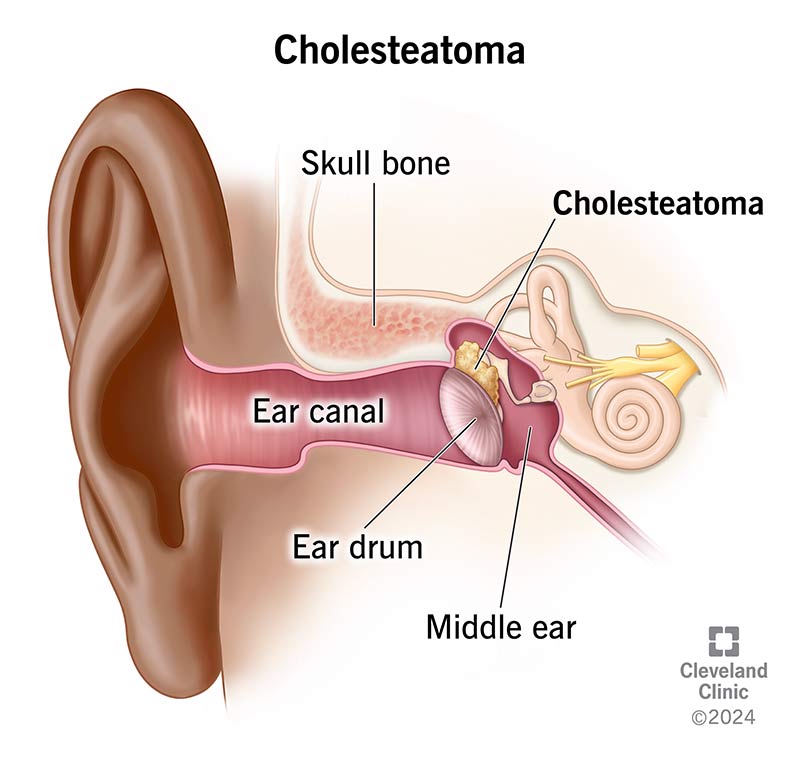Cholesteatoma is an abnormal growth in your middle ear behind your eardrum. It can be congenital (present from birth), but typically happens because you have chronic ear infections. The most common symptom is a smelly discharge from your ear, but the condition can also cause hearing loss and dizziness. Treatment is surgery to remove the growth.
Advertisement
Cleveland Clinic is a non-profit academic medical center. Advertising on our site helps support our mission. We do not endorse non-Cleveland Clinic products or services. Policy

A cholesteatoma is a growth behind your eardrum (tympanic membrane). It develops when dead skin cells gather behind your eardrum to form a lump or cyst that may look like a pearl. You can be born with a cholesteatoma, but it usually happens because you have a retracted eardrum or a ruptured eardrum.
Advertisement
Cleveland Clinic is a non-profit academic medical center. Advertising on our site helps support our mission. We do not endorse non-Cleveland Clinic products or services. Policy
Without treatment, cholesteatomas may become infected or grow large enough to damage your hearing and facial nerve. Surgery to remove the growth is the only way to treat a cholesteatoma.
Symptoms vary depending on whether you’re born with a cholesteatoma (congenital cholesteatoma) or develop one over time (acquired cholesteatoma). Congenital cholesteatomas may not cause symptoms until they get larger. Your child’s pediatrician could find a congenital cholesteatoma in their ear while doing a physical examination. But both congenital and acquired forms of the condition may cause the following symptoms:
Sometimes, the condition can cause hearing loss or tinnitus.
One of the main causes is a retracted eardrum. This is when there’s an imbalance between the air inside and outside of your ear. This causes your middle ear to pull in your eardrum. When that happens, you may develop a cyst or pocket that fills up with skin cells and becomes a cholesteatoma.
Chronic ear infections (acute otitis media) or ruptured eardrums can also lead to cholesteatomas. Rarely, children are born with the condition.
Advertisement
A healthcare provider will ask about your symptoms and medical history, including whether you have a history of ear infections. They’ll examine your ears with an otoscope, a device that lets them look at your eardrum.
If they suspect you have a cholesteatoma, they’ll refer you to an ear, nose and throat specialist (otolaryngologist). Your otolaryngologist may do the following tests:
Treatments depend on the cause and symptoms, but surgeries like mastoidectomy and tympanoplasty are the only ways to remove a cholesteatoma.
If you’re like most people, surgery to remove a cholesteatoma will take care of your symptoms. But cholesteatomas can come back. Your otolaryngologist may recommend that you have regular checkups. Checkups may include:
You can’t prevent congenital cholesteatomas, but there are things you can do to reduce your risk that you’ll develop one:
Contact your otolaryngologist if you have symptoms after surgery like:
You should also contact your otolaryngologist if you have symptoms like ear drainage that could mean you’re developing a new cholesteatoma.
If you’re prone to ear infections, you may have an increased risk of developing a cholesteatoma. This is a growth that develops behind your eardrum. You may not realize it’s there until you have symptoms like smelly, sticky goop coming out of your ear. Without treatment, a cholesteatoma can affect your hearing and cause other issues. If you notice ear goop or other changes, talk to a healthcare provider. They’ll examine your ears and if needed refer you to a specialist for treatment.
Advertisement
Hearing is an important part of your everyday life. Hearing loss can impact your life in so many ways. Cleveland Clinic experts can help you hear clearly again.

Last reviewed on 02/13/2024.
Learn more about the Health Library and our editorial process.